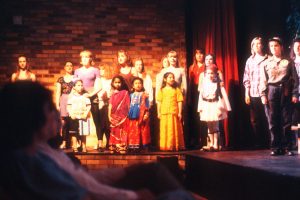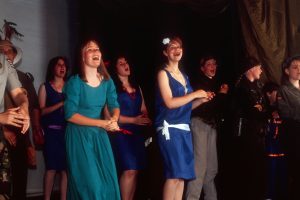History of Child of the Future
 When Child of the Future was written in 1991 it was described as "a new Rock Musical with a difference … Child of the Future marks a new generation of musical "babies" in that it must be the most adaptable, accessible and inexpensive musical new-born to hit the junior school scene."
When Child of the Future was written in 1991 it was described as "a new Rock Musical with a difference … Child of the Future marks a new generation of musical "babies" in that it must be the most adaptable, accessible and inexpensive musical new-born to hit the junior school scene."
It was the offspring of a Hertfordshire resident, Rilla Paterson, who became interested in the idea of setting certain green ideas to music on reading "Where On Earth Are We Going" by Jonathon Porritt. Mr Porritt's book, far from containing prophesies of doom and gloom, has much to offer in the way of positive alternatives. Moreover, music, particularly songs, are a very good learning medium for us, because we tend to remember a song better than we remember a paragraph in a book. The composer felt that this is a very good way of highlighting the task that faces our younger generation, wherein lies the only hope we have.
 At the time it was written, the project was unusually accessible because it was produced on a computer at a time when personal computers were only just becoming available to the general public. The composer used an Archimedes A3000 with the music notation program Rhapsody. This made the musical very accessible and inexpensive for schools, since all the data could be supplied on a 3.1/2" disk for little more than the price of a postage stamp. Many schools had the Archimedes, with a word-processing program capable of reading the lyrics and script files, which were provided in ASCII format. In this way they could access the script and lyrics files, and schools with Rhapsody could access the music scores as well, edit them to requirements and print them out in unlimited numbers. Moreover, provided the computer in use was fitted with a MIDI interface, an alternative accompaniment could be produced simply by assigning different staves to different MIDI channels.
At the time it was written, the project was unusually accessible because it was produced on a computer at a time when personal computers were only just becoming available to the general public. The composer used an Archimedes A3000 with the music notation program Rhapsody. This made the musical very accessible and inexpensive for schools, since all the data could be supplied on a 3.1/2" disk for little more than the price of a postage stamp. Many schools had the Archimedes, with a word-processing program capable of reading the lyrics and script files, which were provided in ASCII format. In this way they could access the script and lyrics files, and schools with Rhapsody could access the music scores as well, edit them to requirements and print them out in unlimited numbers. Moreover, provided the computer in use was fitted with a MIDI interface, an alternative accompaniment could be produced simply by assigning different staves to different MIDI channels.
 The script, lyrics and MIDI files were also made available for the ATARI, so many more schools had a computer capable of reading them. Work was later undertaken to transfer the data onto discs for use with NIMBUS computers as well, but the best outcome was obtained by running Rhapsody on the ARCHIMEDES.
The script, lyrics and MIDI files were also made available for the ATARI, so many more schools had a computer capable of reading them. Work was later undertaken to transfer the data onto discs for use with NIMBUS computers as well, but the best outcome was obtained by running Rhapsody on the ARCHIMEDES.
The script, lyrics and scores were available on loan for photocopying by schools with no compatible computer.
A cassette tape was offered at a very reasonable £5.00. Side A of the cassette featured the voices of 20 children from the local junior school, aptly named Little Green School, Croxley Green, Rickmansworth, singing against a synthesised accompaniment. The high quality digital recording, by Peter Kiely of NSR Ltd, was made at their Stanmore studio under ideal conditions, and was great fun. Side B featured the accompaniment only, so that any school with no orchestra could perform Child of the Future by running Side B of the tape.
The tracks that can be downloaded today from this website are essentially the same as the original 1991 recording, but these have now been re-mastered by Peter Kiely Productions.
The first stage performance of Child of the Future took place at Little Green School in July 1991. They used the school orchestra, with a very wide variety of instruments. Every child in the school took part, and the only adult in the orchestra was the pianist. The orchestral parts were graded so that children at different levels of ability could participate; thus the easy violin and cello parts were all on open strings! Each orchestral part contained the vocal line above, so that children could not lose their way in the music. The scores tended to run to many pages on this account, but if preferred parts could be reformatted, editing out the vocal line, at the touch of a button, using Rhapsody.
 The first public performances were on 13th-15th February, l992, at the Pump House Theatre, Watford, presented by the Star School of Dance and Drama. They used Side B of the tape, with an amplified sound system. The show was very successful, and Watford Borough Council sponsored two repeat performances in May as part of Watford's environmental week. Other schools and youth groups took up the challenge: a local secondary school studied it in the summer term 1992, and the Bushey School of Dance presented a further public performance in October 1992. The composer was able to target schools likely to find the musical of interest by posting a cassette tape to every local authority in the UK which had a music adviser, a total of about 65.
The first public performances were on 13th-15th February, l992, at the Pump House Theatre, Watford, presented by the Star School of Dance and Drama. They used Side B of the tape, with an amplified sound system. The show was very successful, and Watford Borough Council sponsored two repeat performances in May as part of Watford's environmental week. Other schools and youth groups took up the challenge: a local secondary school studied it in the summer term 1992, and the Bushey School of Dance presented a further public performance in October 1992. The composer was able to target schools likely to find the musical of interest by posting a cassette tape to every local authority in the UK which had a music adviser, a total of about 65.
 As a result of an article in the British Overseas Development Newsletter, copies of the musical were sent to Kenya, Malawi, Nigeria, Zambia and Indonesia. The town of Davis, in California, which features in one of the songs, broadcast it over cable TV in the States, resulting in responses from other cities such as Cheyenne and Denver, and the Canadian provinces.
As a result of an article in the British Overseas Development Newsletter, copies of the musical were sent to Kenya, Malawi, Nigeria, Zambia and Indonesia. The town of Davis, in California, which features in one of the songs, broadcast it over cable TV in the States, resulting in responses from other cities such as Cheyenne and Denver, and the Canadian provinces.
The whole project represented a valuable contribution to the teaching of green issues at the time, and these issues are still with us today, with perhaps even more urgency. With the benefit of the internet and a wealth of file conversion systems, it has now been possible for the text files to be transferred from the Acorn computer to the PC, the audio files converted to MP3 and the Rhapsody scores to files which can be imported into a variety of modern notation programs. Thus the whole project can be published via this website and made generally available throughout the world.
 All the material is copyright, but the composer is allowing free of charge downloads for non-profit-making purposes. If users find this material valuable, the composer requests that a modest contribution be made towards the maintenance of this website, and visitors to the site are encouraged to make a donation to an environmental charity of their choice. Details can be found on the CONTACT page.
All the material is copyright, but the composer is allowing free of charge downloads for non-profit-making purposes. If users find this material valuable, the composer requests that a modest contribution be made towards the maintenance of this website, and visitors to the site are encouraged to make a donation to an environmental charity of their choice. Details can be found on the CONTACT page.
